Introduction to Historic Venice
Venice stands as one of the world’s most mesmerizing cities, renowned for its intricate network of canals, shimmering palaces, and a history that pulses beneath every stone. At the heart of this historic city lie two of its most celebrated landmarks: St. Mark’s Basilica and the Doge’s Palace. These architectural masterpieces not only define the Venetian skyline but also offer an unparalleled window into the city’s storied past.
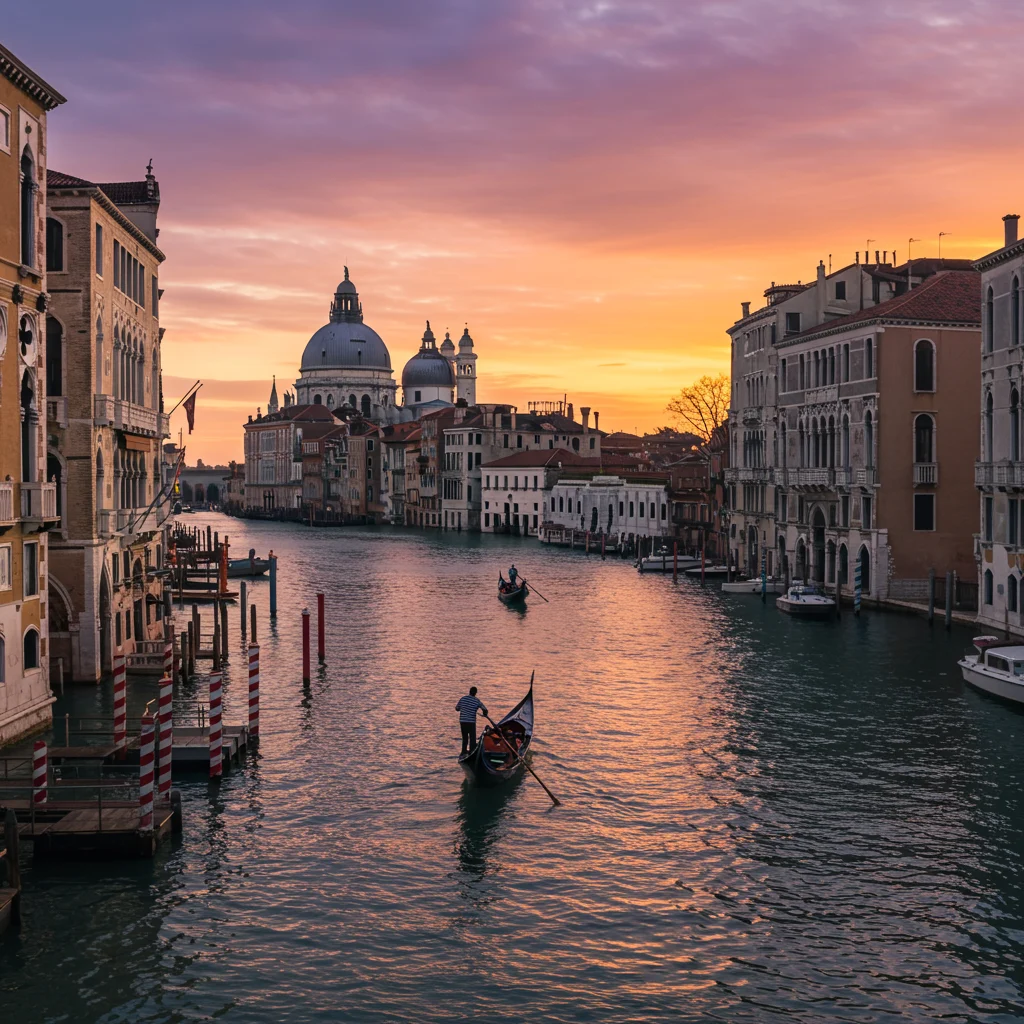
From the ringing bells of St. Mark’s Square to the ornate arches and gilded mosaics, every detail evokes centuries of artistry, power, and devotion. Let us guide you through the wonders of these iconic sites, providing practical advice and fascinating stories to enrich your journey.
Why Are St. Mark’s Basilica and Doge’s Palace Must-See Landmarks?
St. Mark’s Basilica and the Doge’s Palace are more than just tourist attractions—they are the living heart of Venice’s cultural heritage. The basilica dazzles with its golden mosaics and treasures, while the palace reveals the intrigue and grandeur of Venetian governance. Together, they embody the spirit of a city that has inspired generations of artists, scholars, and travelers.
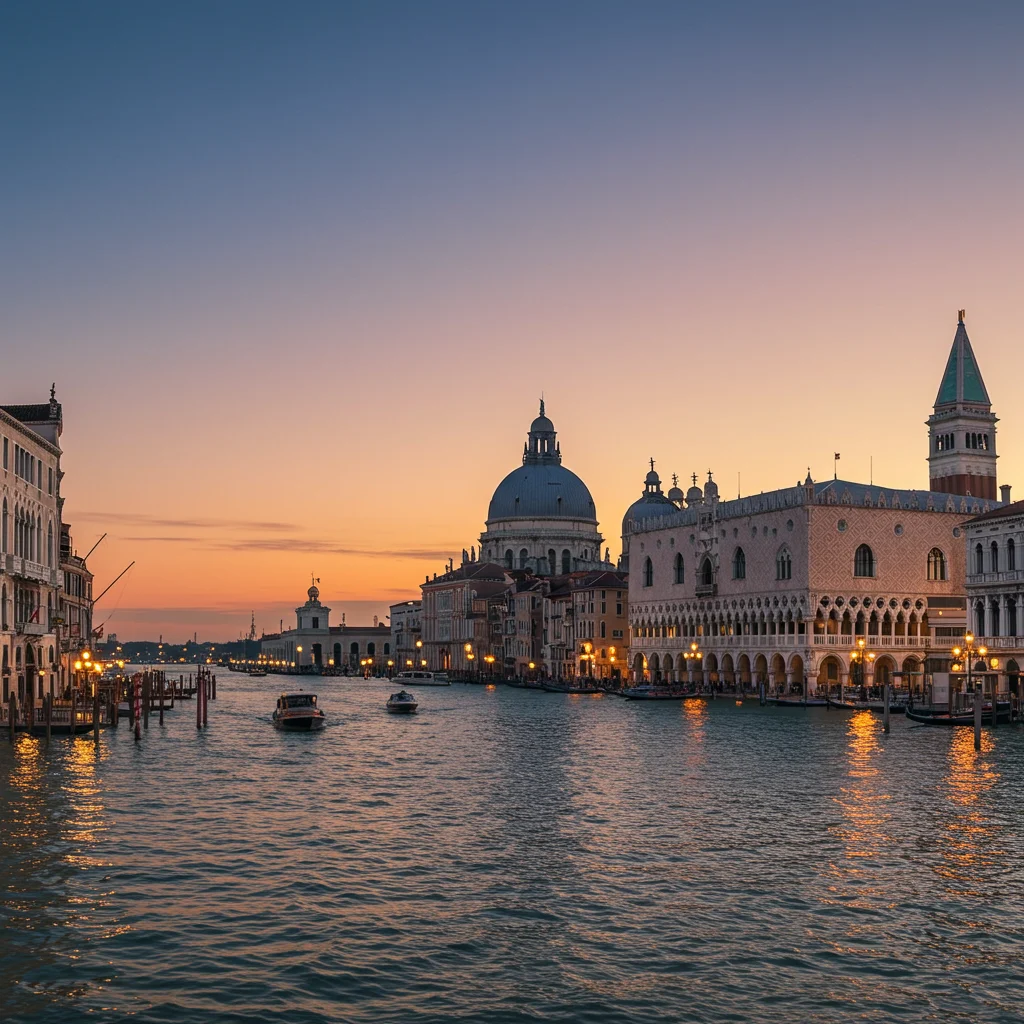
A visit here means walking in the footsteps of dukes, merchants, and pilgrims, surrounded by the sights, scents, and echoes of Venice’s golden age. For a comprehensive introduction to these landmarks and practical tips, you may wish to read our in-depth overview of Venice’s essential highlights.
A Brief History of Venice
Understanding Venice’s two crowning landmarks is impossible without grasping the city’s extraordinary past. Rising from the marshy lagoons, Venice became a beacon of commerce, art, and independent governance.
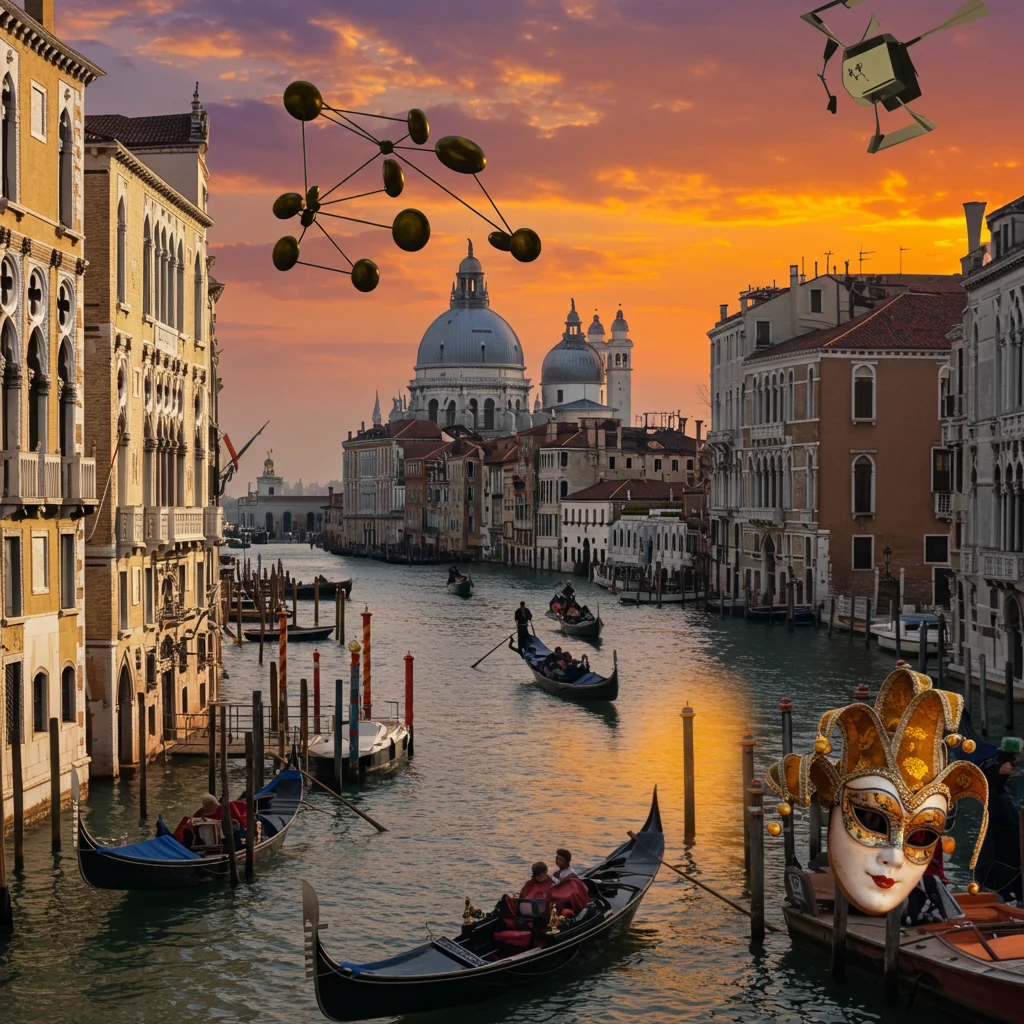
How Did Venice Become a Maritime Power?
Venice’s strategic location on the Adriatic Sea allowed it to control vital trade routes between East and West. By building a powerful fleet and establishing commercial outposts, the city grew wealthy and influential, dominating Mediterranean trade for centuries.
The city’s merchants imported silk, spices, and rare goods, transforming Venice into a cosmopolitan hub. The resulting prosperity financed ambitious building projects, including St. Mark’s Basilica and the Doge’s Palace.
The Role of Religion and Politics in Venetian History
Religion and politics were deeply entwined in Venetian society. The election of the Doge, Venice’s chief magistrate, was both a spiritual and civic event, often celebrated with elaborate ceremonies in St. Mark’s Basilica.
The basilica itself served as the state church, symbolizing divine favor and civic unity. Meanwhile, the Doge’s Palace functioned as the seat of political power, housing courts, councils, and the Doge’s private apartments.
Venice’s Architectural Evolution
Venetian architecture reflects a blend of Byzantine, Gothic, and Renaissance influences, shaped by centuries of trade and contact with distant cultures. Marble columns, pointed arches, and vibrant mosaics all tell the story of a city open to the world.
This unique architectural language reached its zenith in the construction of St. Mark’s Basilica and the Doge’s Palace, where every detail serves both aesthetic and symbolic purposes.
Overview of St. Mark’s Basilica
St. Mark’s Basilica, with its five domes and shimmering façade, is a masterpiece of religious architecture. For over a thousand years, it has stood as a testament to Venice’s devotion, wealth, and artistic ambition.
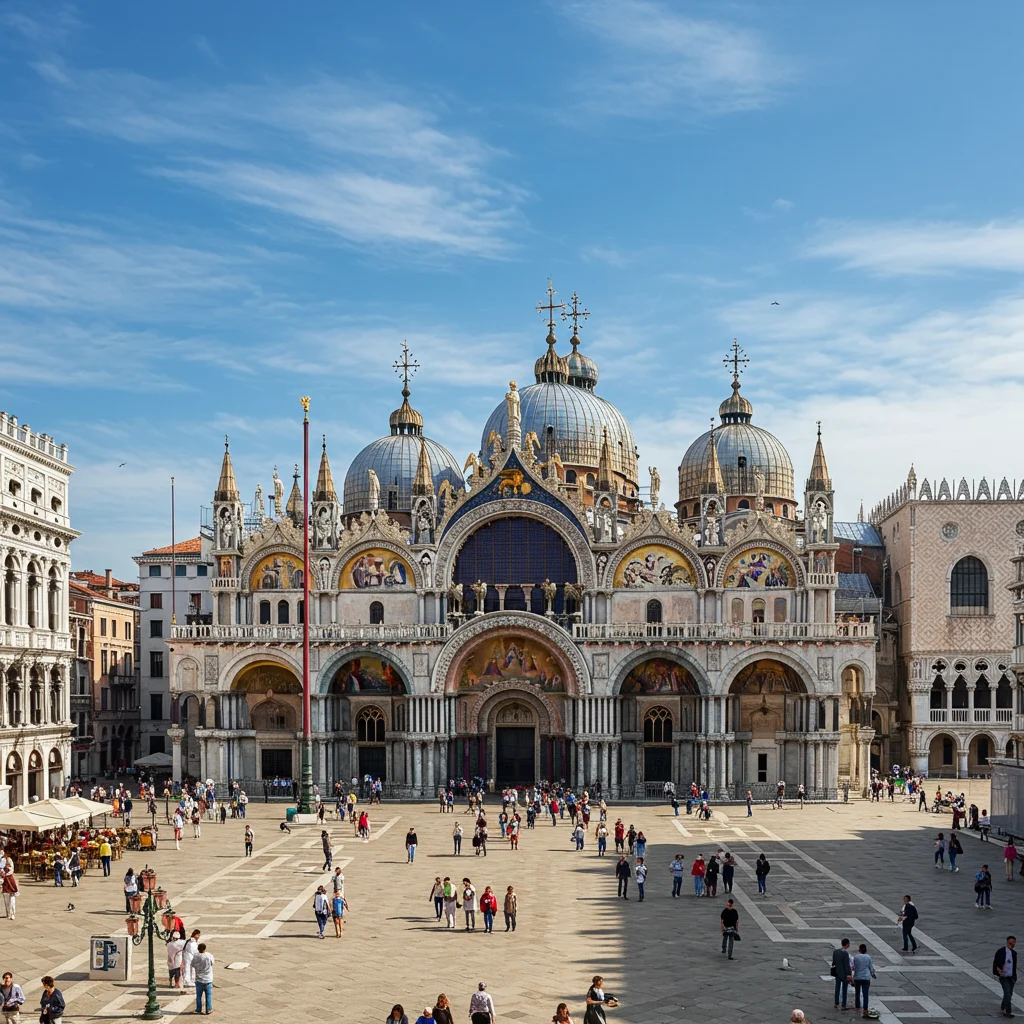
What Makes St. Mark’s Basilica Unique?
No other church in the world matches the basilica’s combination of Byzantine splendor and Venetian ingenuity. Over 8,000 square meters of golden mosaics cover its interior, casting a warm, ethereal glow as sunlight filters through high windows.
The basilica’s treasures, from the Pala d’Oro to the famous bronze horses, reveal a city that spared no expense in honoring its patron saint.
The Origins and Construction of St. Mark’s Basilica
The basilica was originally built in the 9th century to house the relics of St. Mark the Evangelist, which Venetian merchants reportedly smuggled from Alexandria. Over the centuries, the church was rebuilt and embellished, absorbing influences from Constantinople, the Middle East, and Western Europe.
Each phase of construction added new layers of artistry—marble floors, intricate mosaics, and sculpted portals—resulting in the dazzling monument we see today.
How Has St. Mark’s Basilica Changed Over Time?
St. Mark’s Basilica has undergone continual transformation. Fires, floods, and political upheavals often necessitated repairs and restorations. The basilica’s mosaics, for instance, have been replaced or updated in different eras, reflecting changing tastes and techniques.
Today, the basilica stands as a palimpsest of Venetian history, where ancient gold leaf rubs shoulders with Renaissance art and Baroque embellishments.
Exploring the Exterior of St. Mark’s Basilica
The exterior of St. Mark’s Basilica is a visual feast, with its ornate arches, marble columns, and glittering mosaics. The façade alone warrants a closer look, as each detail tells a story of faith and triumph.
The Iconic Facade: What to Look For
The façade of St. Mark’s is a riot of color and texture, adorned with spires, statues, and bas-reliefs. Look for the four bronze horses above the central portal, the gilded mosaics that recount biblical tales, and the intricate carvings that line the arches.
Soft morning light bathes the façade in gold, while the bustle of St. Mark’s Square adds a lively soundtrack to your visit.
The Horses of St. Mark’s: History and Significance
The four bronze horses, known as the “Quadriga,” are among the basilica’s most famous treasures. Originally part of a Roman monument, they were brought to Venice from Constantinople in the 13th century.
Today, the originals are preserved inside the basilica’s museum, while replicas stand guard above the entrance. These horses symbolize Venice’s power and its far-reaching influence.
Mosaics and Sculptures on the Exterior
Vivid mosaics depict scenes from the life of Christ and St. Mark, their colors gleaming in the Mediterranean sun. Marble statues of apostles, angels, and saints seem to watch over the square, their faces weathered by centuries of salt air.
Every inch of the façade invites curiosity, rewarding close inspection with stories and secrets from Venice’s past.
Inside St. Mark’s Basilica: A Room-by-Room Guide
Stepping inside St. Mark’s Basilica, visitors are enveloped in a golden glow. Each space reveals a different aspect of Venetian faith and artistry, from the grand nave to the mysterious crypt.
The Narthex: First Impressions
The narthex, or entrance hall, sets the tone for your visit. Mosaics above the doors depict scenes from the Old Testament, their colors deep and luminous. The floor, inlaid with intricate marble patterns, echoes beneath your footsteps.
Here, the air is cool and scented with incense, heightening the sense of anticipation.
The Nave and Its Glittering Mosaics
The nave dazzles with its expansive mosaic ceilings, where gold leaf and colored glass create shifting patterns of light. Scenes from the life of Christ, the Virgin Mary, and St. Mark unfold overhead, each rendered with exquisite detail.
The atmosphere is hushed, punctuated only by the soft murmur of visitors and the distant echo of choir music.
The Pala d’Oro: What Is It and Why Is It Famous?
The Pala d’Oro is a masterpiece of medieval goldsmithing, encrusted with hundreds of gems and enamels. This stunning altarpiece, commissioned from Byzantine and Venetian artists, stands behind the high altar and is revealed only during special ceremonies.
Its intricate panels depict saints and biblical scenes, shimmering in candlelight—a testament to Venice’s devotion and wealth.
Treasures of the Treasury: What Can You See?
The basilica’s treasury houses a dazzling collection of relics, chalices, and liturgical objects, many brought from Constantinople after the Fourth Crusade. Among the highlights are ancient icons, jeweled crosses, and ornate reliquaries.
Each artifact tells a story of faith, conquest, and artistic achievement.
The Crypt: Secrets Beneath the Basilica
Beneath the basilica lies the atmospheric crypt, where the remains of St. Mark are believed to rest. The space is dimly lit, with low vaults and marble columns creating a sense of mystery and reverence.
Floodwaters occasionally seep into the crypt, adding to its enigmatic allure.
The Museum and Loggia dei Cavalli
The basilica’s museum offers a closer look at the original bronze horses and other precious artifacts. From the Loggia dei Cavalli, visitors enjoy sweeping views of St. Mark’s Square, with the basilica’s domes rising majestically overhead.
This vantage point provides a unique perspective on both the church and the city beyond.
What Do the Mosaics Depict?
The mosaics of St. Mark’s Basilica are a visual narrative of Venetian faith and identity. Covering every surface, they chronicle the city’s spiritual journey and celebrate its patron saint.
Religious Symbolism in the Artworks
Biblical stories unfold in gold and glass, with Christ, the apostles, and the Virgin Mary at the center. Angels, prophets, and saints populate the domes, each gesture and color imbued with meaning.
The mosaics serve both as decoration and as a teaching tool, illustrating key moments of Christian belief for generations of worshippers.
Byzantine Influences on the Interior
Byzantine artistry dominates the basilica’s interiors, evident in the stylized figures, rich colors, and elaborate patterns. Venetian artists learned from their Eastern counterparts, blending local traditions with techniques imported from Constantinople.
The result is a luminous, otherworldly space that feels both ancient and timeless.
Practical Tips for Visiting St. Mark’s Basilica
A thoughtful approach will help you appreciate the basilica’s beauty while respecting its spiritual significance.
Best Times to Visit and Avoid Crowds
Early mornings and late afternoons tend to be quieter, especially outside peak tourist seasons. Weekdays are generally less crowded than weekends, allowing for a more contemplative visit.
Booking ahead through authorized sites or with providers like Viator can help you secure a timed entry and minimize waiting.
Dress Code and Entry Requirements
As a place of worship, St. Mark’s Basilica requires modest attire: shoulders and knees should be covered. Large bags and backpacks are not permitted inside, and security checks are routine.
Admission is free for the main basilica, but access to the museum, treasury, and Pala d’Oro requires a small fee.
Photography Rules and Accessibility
Photography is not allowed inside the basilica itself, preserving the peaceful atmosphere and protecting the artwork. The basilica is partially accessible for visitors with mobility challenges, though some areas—like the museum and loggia—require climbing stairs.
If accessibility is a priority, inquire in advance about available accommodations.
Overview of the Doge’s Palace (Palazzo Ducale)
The Doge’s Palace stands beside St. Mark’s Basilica, its pink-and-white marble façade reflecting in the canals below. For centuries, this palace was the seat of Venetian government, a labyrinth of grand halls, secret chambers, and echoing courtyards.
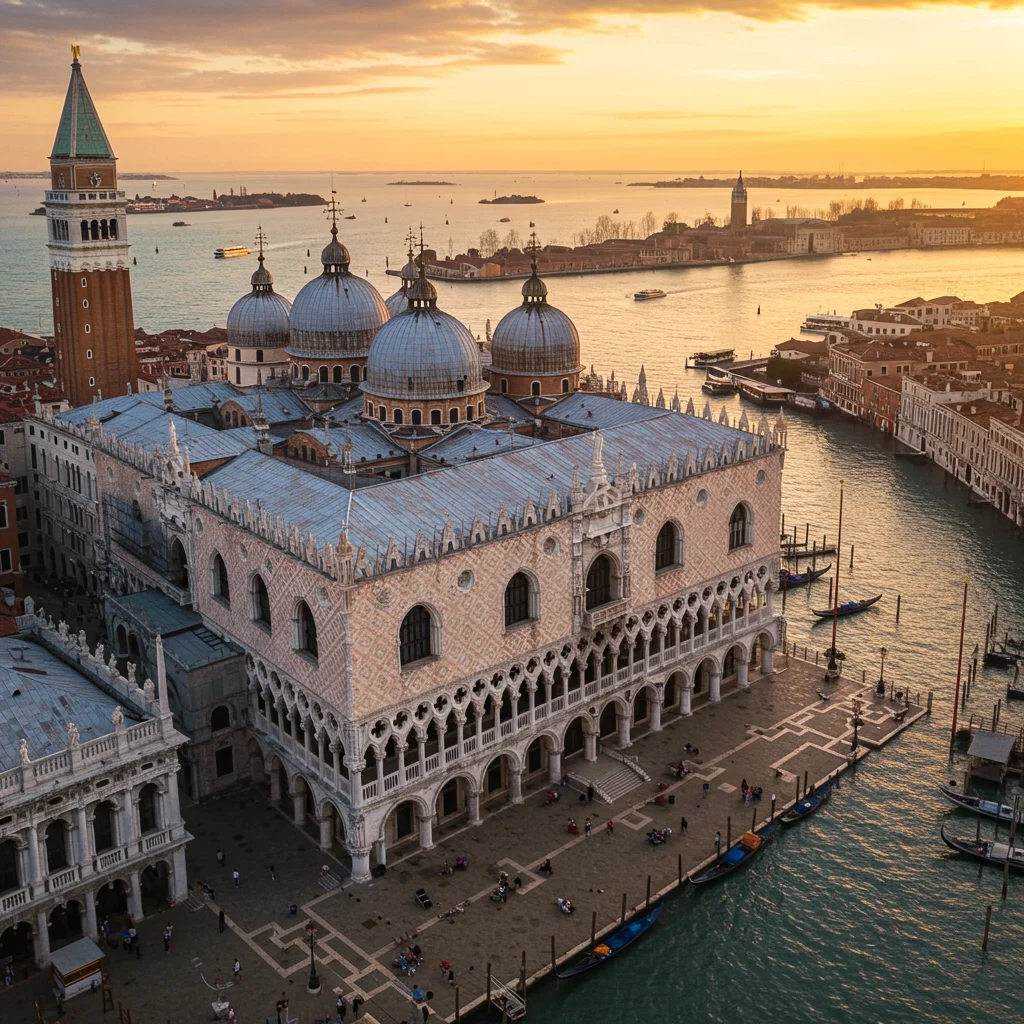
What Was the Doge’s Palace Used For?
The Doge’s Palace served as the residence of the Doge, Venice’s elected leader, as well as the center of political power. Here, councils convened, laws were passed, and justice was dispensed.
The palace also housed courtrooms, administrative offices, and even prison cells, making it the nerve center of the Venetian Republic.
The History of the Doge’s Palace: From Fortress to Museum
Originally constructed as a fortified castle in the 9th century, the Doge’s Palace evolved over time into a symbol of Venetian authority and sophistication. Fire, war, and political change prompted repeated expansions and renovations.
Today, the palace is a museum, its rooms filled with masterpieces and echoes of intrigue, offering visitors a glimpse into the complexities of Venetian governance.
Architectural Styles and Features of the Doge’s Palace
The palace showcases a harmonious blend of Gothic, Moorish, and Renaissance elements. Delicate tracery, pointed arches, and elaborate capitals define the exterior, while rich frescoes and gilded ceilings adorn the interiors.
Each architectural detail serves both practical and symbolic purposes, reflecting Venice’s wealth and cosmopolitan outlook.
Exploring the Exterior: Facades, Courtyards, and Statues
The palace’s exterior is both imposing and graceful, with sculpted balconies and soaring arcades. The main entrance and central courtyard set the stage for the opulence found within.
The Porta della Carta: Venice’s Grand Entrance
The Porta della Carta, or “Paper Gate,” is the palace’s ceremonial entrance, richly decorated with carvings and statues. Here, the Doge would greet visiting dignitaries beneath the watchful gaze of St. Mark’s lion.
This gateway remains a favorite spot for photographs, framing the palace’s grandeur against the bustle of the square.
The Courtyard and Its Monuments
The central courtyard is an oasis of marble and sunlight, enclosed by arcades and overlooked by the palace’s towers. Statues of illustrious Venetians and mythological figures stand amidst lush greenery, their features softened by centuries of weather.
From here, grand staircases ascend to the palace’s ceremonial halls.
Inside the Doge’s Palace: Major Rooms and Highlights
Within the palace, a series of opulent rooms reveal the inner workings of Venetian power and culture. Each space offers its own atmosphere, from the gilded grandeur of council chambers to the somber silence of prison cells.
The Golden Staircase (Scala d’Oro)
The Scala d’Oro, or “Golden Staircase,” is a masterpiece of Renaissance design. Its gilded stuccoes and marble steps once welcomed ambassadors and nobles, setting the tone for the splendor that awaited above.
Ascending the staircase, visitors catch glimpses of frescoed ceilings and ornate doorways, each a testament to Venetian artistry.
The Doge’s Apartments
The private apartments of the Doge are elegantly furnished, with painted ceilings, antique furniture, and views over the city. These chambers provide a rare insight into the daily life of Venice’s most powerful figure.
Personal objects and portraits bring the past vividly to life.
The Institutional Chambers: Halls of Power
The palace’s grand halls—including the Hall of the Senate, the Hall of the Council of Ten, and the Hall of the Collegio—were the stage for debates, ceremonies, and the passage of laws. Richly decorated with portraits, allegories, and gilded woodwork, these rooms radiate authority.
Their walls have witnessed decisions that shaped the destiny of Venice and its empire.
The Chamber of the Great Council: Venice’s Largest Room
This vast chamber, among the largest in Europe, hosted meetings of the Great Council, where hundreds of Venetian nobles assembled to govern the republic. The ceiling is adorned with paintings by Veronese and Tintoretto, while the walls depict historic victories and allegorical scenes.
The sheer scale and artistry of the chamber leave a lasting impression on all who enter.
The Armoury: Weapons and Armor Collection
The palace’s armoury contains an impressive array of swords, suits of armor, and military relics. These objects evoke the martial spirit that once defended Venice’s independence and prosperity.
Intricately decorated weapons offer a window into the craftsmanship and innovation of Venetian artisans.
The Prisons and the Bridge of Sighs
Connected to the palace by a covered bridge, the prisons housed those who ran afoul of Venetian law. The contrast between the palace’s luxury and the starkness of the cells is striking.
What Is the Bridge of Sighs and Why Is It Famous?
The Bridge of Sighs is an enclosed limestone passage linking the palace to the prisons. Its poetic name comes from the idea that prisoners, catching their last glimpse of Venice through its small windows, would sigh at the view.
Today, the bridge is a symbol of both romance and melancholy, immortalized in art and literature.
Life in the Venetian Prisons
Prisoners faced harsh conditions: damp cells, minimal light, and little comfort. Some, like the infamous Giacomo Casanova, managed daring escapes; others languished in darkness, their stories lost to time.
The prisons serve as a sobering counterpoint to the palace’s opulence, reminding us of the republic’s strict justice.
Art and Frescoes in the Doge’s Palace
The palace’s walls and ceilings are adorned with some of the greatest masterpieces of the Venetian Renaissance. Art and power were inseparable, as rulers commissioned works to glorify the city and its institutions.
Masterpieces by Tintoretto, Veronese, and Others
Vast canvases by Tintoretto, Veronese, and Bellini fill the halls with vibrant color and drama. The “Paradise” in the Great Council Chamber is among the largest oil paintings in the world, its swirling figures bathed in celestial light.
Each painting is a feast for the senses, inviting viewers to linger and reflect.
Symbolism and Themes in the Palace’s Art
Allegories of justice, wisdom, and civic virtue dominate the palace’s iconography. Scenes of Venice’s triumphs, saints protecting the city, and classical motifs reinforce the republic’s ideals.
As experts often say:
“Venetian art is not only beautiful but also deeply political—every brushstroke affirms the city’s identity and values.”
Notable Events and Stories from the Doge’s Palace
The Doge’s Palace has been the stage for dramatic events, from political conspiracies to legendary escapes.
Political Intrigue and Historic Trials
Secret councils met in shadowy chambers to decide the fate of accused traitors and rivals. Trials were conducted with elaborate rituals, and punishments could be severe. The palace’s archives are filled with tales of ambition, betrayal, and justice.
These stories bring Venice’s history alive, offering lessons in the complexities of power.
Legends and Myths of the Doge’s Palace
Legends abound within the palace walls, from ghostly apparitions to hidden treasures. The most famous is the story of Casanova’s escape, which has inspired countless retellings and adds an air of romance to the palace’s formidable reputation.
Such myths continue to intrigue visitors, blending history and imagination.
Practical Tips for Visiting the Doge’s Palace
Planning your visit to the Doge’s Palace will help you make the most of this remarkable site.
How to Buy Tickets and Book Tours
Tickets can be purchased online or at the entrance, but lines can be long, especially during peak season. Booking in advance through platforms like Viator allows you to secure a spot and access guided tours that offer deeper insights.
Combined tickets are available for multiple sites in St. Mark’s Square, providing excellent value for those eager to see more.
Best Times to Visit and Accessibility
Early mornings and late afternoons tend to be less crowded. The palace is accessible to visitors with mobility challenges, with elevators and ramps available in most areas.
Check ahead for special exhibitions or temporary closures that may affect your visit.
What to Expect on a Guided Tour
Guided tours offer a wealth of stories and context, bringing the palace’s history and artworks to life. Knowledgeable guides share anecdotes about the Doges, the city’s political structure, and the secrets hidden behind closed doors.
For a detailed itinerary combining both the basilica and palace, see our recommendations in our Venice essentials guide.
St. Mark’s Square: The Heart of Venice
St. Mark’s Square, or Piazza San Marco, is the vibrant center of Venetian life. Surrounded by architectural marvels and animated by the rhythms of daily life, the square offers endless opportunities for discovery.

What Else Can You See in St. Mark’s Square?
Beyond the basilica and palace, the square is home to historic towers, elegant cafés, and centuries-old traditions.
The Campanile and Its Panoramic Views
The Campanile, or bell tower, rises 99 meters above the square, offering breathtaking views of Venice’s rooftops, canals, and distant islands. On clear days, the Alps are visible on the horizon.
A gentle breeze greets you at the top, mingling with the sound of bells and the distant hum of the city.
The Clock Tower and Its History
The Torre dell’Orologio, with its striking blue and gold clock face, has marked the hours since the 15th century. Mechanical figures emerge to strike the bell, delighting visitors with a spectacle that blends art and technology.
The clock tower also houses an astronomical dial, reflecting Venice’s fascination with science and navigation.
Cafés and Venetian Traditions in the Square
Elegant cafés line the square, their terraces filled with the aroma of fresh coffee and pastries. Sipping espresso beneath the porticoes, you can watch the ebb and flow of Venetian life—musicians playing, children chasing pigeons, and artists sketching the basilica.
For an insider’s perspective on the city’s culinary delights, our post about Venetian food tours offers recommendations nearby.
Venetian Culture and Daily Life Around St. Mark’s
The neighborhoods surrounding St. Mark’s Square pulse with energy, blending tradition and modernity in daily rituals and festive celebrations.
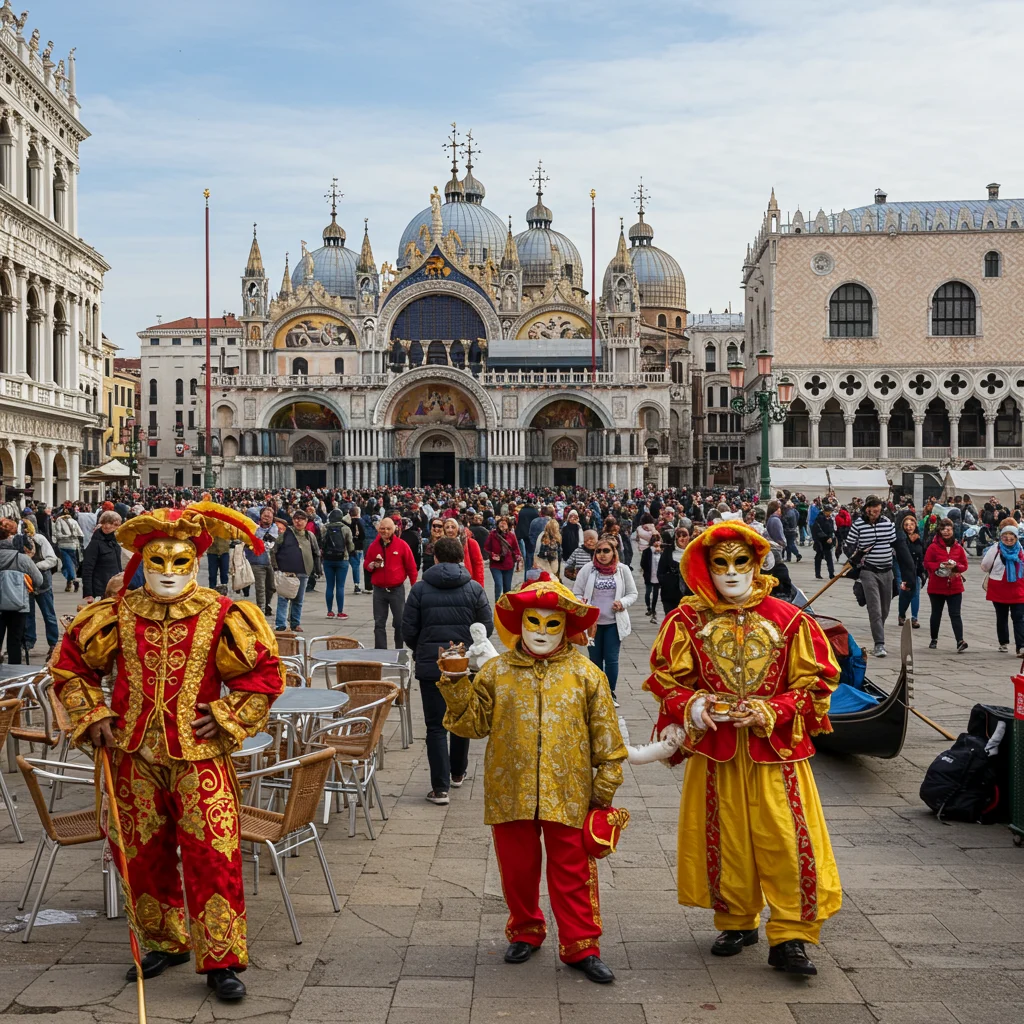
Festivals and Events in St. Mark’s Square
Throughout the year, St. Mark’s Square hosts a variety of festivals, from the exuberant Carnevale with its elaborate masks to solemn religious processions. Music, dance, and fireworks fill the air, creating unforgettable memories for locals and visitors alike.
These events reflect the city’s enduring spirit and its ability to reinvent itself while honoring its past.
The Role of St. Mark’s and Doge’s Palace in Venetian Identity
St. Mark’s Basilica and the Doge’s Palace are more than monuments—they are touchstones of Venetian identity. Generations have gathered here to celebrate victories, mourn losses, and reaffirm their connection to the city’s unique story.
The enduring presence of these landmarks shapes the rhythms of daily life, inspiring pride and reverence in all who call Venice home.
Frequently Asked Questions About Visiting St. Mark’s and Doge’s Palace
Visitors often have practical questions about making the most of their time in Venice. Here, we address the most common inquiries.

How Much Time Should You Spend at Each Site?
We recommend allocating at least 60–90 minutes for St. Mark’s Basilica, especially if you plan to visit the museum or treasury. The Doge’s Palace deserves two to three hours, allowing time to explore its many rooms and exhibitions.
Those with a keen interest in art or history may wish to linger even longer.
Are There Combined Tickets or Passes?
Yes, combined tickets are available for St. Mark’s Basilica, the Doge’s Palace, and other nearby museums. These passes offer convenience and savings, especially for those eager to see multiple sites in one day.
Check official websites or trusted platforms like Viator for the latest options and pricing.
Is It Possible to Visit Both in One Day?
Absolutely. Many visitors start at St. Mark’s Basilica in the morning, then tour the Doge’s Palace in the afternoon. Guided tours often combine both sites, providing a seamless and informative experience. For those looking to optimize their itinerary, our article on Venice’s top highlights offers helpful planning tips.
Accessibility for Visitors With Disabilities
Both landmarks offer accessibility features, including ramps, elevators, and reserved seating. Some areas, such as upper galleries or the loggia, may be challenging for those with mobility limitations.
We advise contacting the sites in advance for specific accommodations.
Tips for Families and Group Travelers
Families will find both attractions engaging, though young children may tire during lengthy tours. Audio guides and interactive exhibits help keep all ages interested. Group tours offer the advantage of expert commentary and efficient navigation through the sites.
Consider breaking up your visit with a relaxed meal or a scenic gondola ride—our Venice tour guide provides inspiration for memorable family experiences.
Nearby Attractions to Explore After Your Visit
Once you have experienced the marvels of St. Mark’s and the Doge’s Palace, the surrounding area offers a wealth of additional sights and experiences.

What Are the Best Places to Eat Near St. Mark’s Square?
The streets around the square are dotted with trattorias, wine bars, and pastry shops. For an authentic Venetian meal, look for restaurants serving cicchetti (small plates), risotto al nero di seppia, or freshly caught seafood.
Aromatic espresso and sweet pastries await in historic cafés, where marble tables and gilded mirrors recall Venice’s golden past.
Hidden Gems Close to St. Mark’s and the Doge’s Palace
Beyond the main attractions, you’ll find secluded courtyards, artisan workshops, and quiet canals. The nearby islands of Murano and Burano offer colorful houses, glassmaking demonstrations, and a peaceful retreat from the crowds.
These lesser-known spots reveal the quieter, more intimate side of Venice.
Souvenir Shopping: What to Buy in the Area?
Shops near St. Mark’s Square offer treasures ranging from hand-blown Murano glass and delicate lace to gilded masks and leather-bound journals. Many artisans continue centuries-old traditions, crafting unique pieces that make meaningful mementos of your visit.
Take time to browse, ask questions, and select a keepsake that reflects your personal connection to Venice.
How to Book on Viator
Booking your visit to St. Mark’s Basilica and the Doge’s Palace is simple with Viator. This trusted platform allows you to find tours, skip the line with priority tickets, and join expert-led experiences.

Simply visit the Viator website, search for your preferred dates and activities, and select from a range of options tailored to your interests. Viator’s clear descriptions, verified reviews, and secure booking process make it easy to plan your trip with confidence.
For those looking to combine multiple attractions, Viator also offers curated packages that cover St. Mark’s Basilica, the Doge’s Palace, and other Venetian highlights.
Conclusion: Experiencing the Magic of Historic Venice
How to Make the Most of Your Visit to St. Mark’s and Doge’s Palace
A journey through St. Mark’s Basilica and the Doge’s Palace is a journey into the soul of Venice. By approaching each site with curiosity and respect, you’ll uncover layers of history, artistry, and daily life that continue to shape the city today.

Take time to savor the golden mosaics, peer through the Bridge of Sighs, and linger in the bustling square. Each moment offers new insights and connections, enriching your understanding of Venice’s enduring legacy.
Preserving Venice’s Heritage for Future Generations
Venice’s treasures are fragile, shaped by centuries and threatened by the passage of time. By supporting responsible tourism and appreciating the city’s unique character, we help safeguard its heritage for those who will walk these storied streets after us.
At Izase, we are passionate about sharing the wonders of Venice and inspiring thoughtful, memorable travel experiences. For more expert advice and in-depth guides, visit Izase.com.
Disclaimer: This information is accurate to the best of our knowledge; however, there may be changes or mistakes. Please verify exact details on the Viator booking page.


